Candesartan Cilexetil CAS 145040-37-5 Assay 99.0~101.0% API EP Standard
Ruifu Chemical is the leading supplier of Candesartan Cilexetil (CAS: 145040-37-5) with high quality, can meet the EP standard. Ruifu has been supplying APIs and pharmaceutical intermediates more than 15 years.
Ruifu Chemical can provide worldwide delivery, competitive price, excellent service.
Purchase Candesartan Cilexetil and its intermediates, please contact us by e-mail: alvin@ruifuchem.com
Ruifu Chemical Supply Candesartan Cilexetil Intermediate With High Purity
Candesartan Cilexetil CAS 145040-37-5
Candesartan CAS 139481-59-7
1-Chloroethyl Cyclohexyl Carbonate CAS 99464-83-2
Candesartan Cilexetil Intermediate Eethyl Ester C6 CAS 139481-41-7
Candesartan Cilexetil Intermediate CAS 139481-44-0
Trityl Candesartan Cilexetil CAS 170791-09-0
| Chemical Name | Candesartan Cilexetil |
| Synonyms | TCV-116; 1-(((Cyclohexyloxy)carbonyl)oxy)ethyl 1-((2'-(1H-tetrazol-5-yl)-[1,1'-biphenyl]-4-yl)methyl)-2-ethoxy-1H-benzo[d]imidazole-7-Carboxylate |
| CAS Number | 145040-37-5 |
| Stock Status | In Stock, Production Scale Up to Tons |
| Molecular Formula | C33H34N6O6 |
| Molecular Weight | 610.66 |
| Density | 1.37±0.10 g/cm3 |
| Melting Point | 168.0-170.0℃ |
| COA & MSDS | Available |
| Storage Condition | 2-8℃ |
| Sensitive | Sensitive to Heat |
| Origin of Product | Shanghai, China |
| Product Categories | API (Active Pharmaceutical Ingredient) |
| Brand | Ruifu Chemical |
| Items | Specifications | Results |
| Appearance | White or almost white powder | White powder |
| Identification-IR | Conform to the reference spectrum | Conforms |
| Identification- UV | Maximal absorptions at 254nm, minimum absorption at 242nm | Conforms |
| Water (K.F) | ≤0.30% | 0.19% |
| Residual Solvents | ||
| Methanol | ≤3000ppm | Not Detected |
| Ethanol | ≤5000ppm | Not Detected |
| Ethyl Ether | ≤5000ppm | 62ppm |
| Acetone | ≤5000ppm | 505ppm |
| Ethyl Acetate | ≤5000ppm | Not Detected |
| Dichloromethane | ≤600ppm | Not Detected |
| Dimethylformamide | ≤880ppm | Not Detected |
| Related Substances | ||
| Impurity A | ≤0.15% | 0.04% |
| Impurity B | ≤0.30% | 0.03% |
| Impurity F | ≤0.20% | 0.02% |
| Impurity G | ≤0.20% | 0.04% |
| Impurity H | ≤0.15% | Not Detected |
| Other Individual Impurity | ≤0.10% | 0.04% |
| Total Impurities | ≤0.60% | 0.23% |
| Sulfated Ash | ≤0.10% | 0.07% |
| Heavy Metals | ≤10ppm | <10ppm |
| Assay (Dried substance) | 99.0~101.0% | 99.9% |
| Test Standard | EP Standard | Conforms |
Package: Bottle, Aluminium foil bag, 25kg/cardboard drum, or according to customer's requirement.
Storage Condition: Keep the container tightly closed. Store in a cool, dry (2-8℃) and well-ventilated warehouse away from incompatible substances. Keep away from sunshine; avoid fire and heat sources; avoid moisture.
Shipping: Deliver to worldwide by air, by sea, by FedEx / DHL Express. Provide fast and reliable delivery.

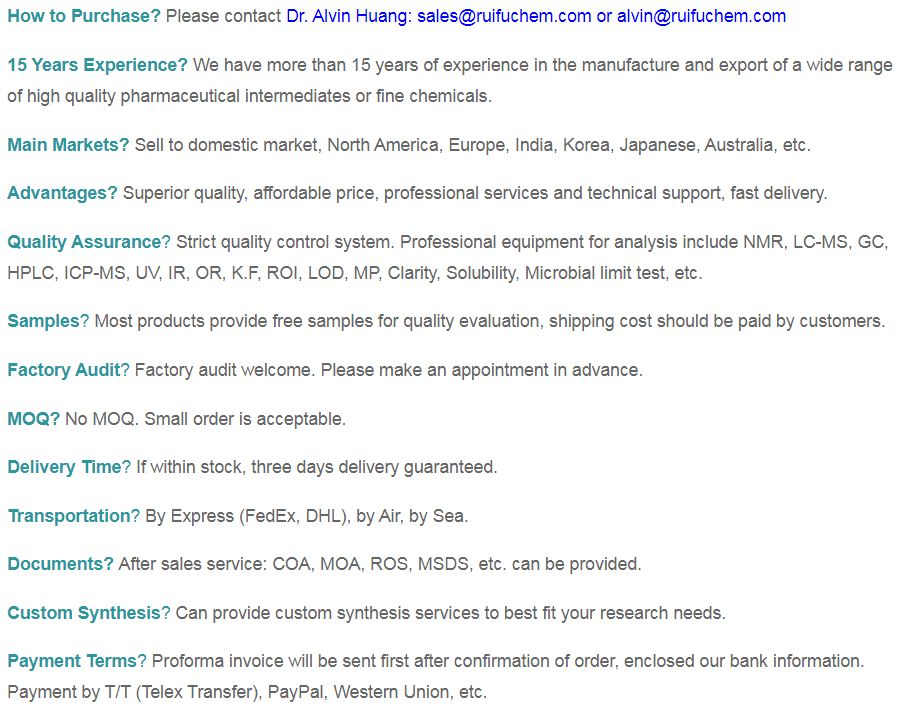
Risk Codes
R20/21/22 - Harmful by inhalation, in contact with skin and if swallowed.
R36/37/38 - Irritating to eyes, respiratory system and skin.
R50 - Very Toxic to aquatic organisms
R48/20 -
R61 - May cause harm to the unborn child
Safety Description
S26 - In case of contact with eyes, rinse immediately with plenty of water and seek medical advice.
S36 - Wear suitable protective clothing.
S61 - Avoid release to the environment. Refer to special instructions / safety data sheets.
S45 - In case of accident or if you feel unwell, seek medical advice immediately (show the label whenever possible.)
S53 - Avoid exposure - obtain special instructions before use.
WGK Germany 3
RTECS DD6672500
HS Code 2933990099
Candesartan Cilexetil (TCV-116) (CAS: 145040-37-5) is an angiotensin II receptor antagonist with IC50 of 0.26 nM, used in the treatment of hypertension. Candesartan is an angiotensin-receptor blocker (ARB) that may be used alone or with other agents to treat hypertension. It is administered orally as the prodrug, candesartan cilexetil, which is rapidly converted to its active metabolite, candesartan, during absorption in the gastrointestinal tract. Candesartan lowers blood pressure by antagonizing the renin-angiotensin-aldosterone system (RAAS); it competes with angiotensin II for binding to the type-1 angiotensin II receptor (AT1) subtype and prevents the blood pressure increasing effects of angiotensin II. Unlike angiotensin-converting enzyme (ACE) inhibitors, ARBs do not have the adverse effect of dry cough. Candesartan may be used to treat hypertension, isolated systolic hypertension, left ventricular hypertrophy and diabetic nephropathy. It may also be used as an alternative agent for the treatment of heart failure, systolic dysfunction, myocardial infarction and coronary artery disease.
CANDESARTAN CILEXETIL
Candesartanum cilexetili
C33H34N6O6 Mr 611
[145040-37-5]
DEFINITION
(1RS)-1-[[(Cyclohexyloxy)carbonyl]oxy]ethyl
2-ethoxy-1-[[2′-(1H-tetrazol-5-yl)biphenyl-4-yl]methyl]-1H-benzimidazole-7-carboxylate.
Content: 99.0 per cent to 101.0 per cent (anhydrous substance).
PRODUCTION
As N-nitrosamines are classified as probable human carcinogens, their presence in candesartan cilexetil should be avoided or limited as much as possible. For this reason, manufacturers of candesartan cilexetil for human use are expected to perform an assessment of the risk of N-nitrosamine formation and contamination during their manufacturing process; if this assessment identifies a potential risk, the manufacturing process should be modified to minimise contamination and a control strategy implemented to detect and control N-nitrosamine impurities in candesartan cilexetil. The general chapter 2.5.42. N-Nitrosamines in active substances is available to assist manufacturers.
CHARACTERS
Appearance: white or almost white powder.
Solubility: practically insoluble in water, freely soluble in methylene chloride and slightly soluble in anhydrous ethanol.
It shows polymorphism (5.9).
IDENTIFICATION
Infrared absorption spectrophotometry (2.2.24).
Comparison: candesartan cilexetil CRS.
If the spectra obtained show differences, dissolve the substance to be examined and the reference substance separately in anhydrous ethanol R, evaporate to dryness and record new spectra using the residues.
TESTS
Related substances. Liquid chromatography (2.2.29). Prepare the solutions immediately before use.
Solvent mixture: water R, acetonitrile R (40:60 V/V).
Test solution. Dissolve 20 mg of the substance to be examined in 50.0 mL of the solvent mixture.
Reference solution (a). Dilute 1.0 mL of the test solution to 100.0 mL with the solvent mixture. Dilute 1.0 mL of this solution to 10.0 mL with the solvent mixture.
Reference solution (b). Dissolve 5 mg of candesartan cilexetil for system suitability CRS (containing impurities A, B and F) in the solvent mixture and dilute to 10 mL with the solvent mixture.
Reference solution (c). Dissolve 2.5 mg of candesartan cilexetil for peak identification CRS (containing impurities G and H) in the solvent mixture and dilute to 5 mL with the solvent mixture.
Column:
- size: l = 0.15 m, Ø = 3.9 mm;
- stationary phase: end-capped octadecylsilyl silica gel for
chromatography R (4 μm).
Mobile phase:
- mobile phase A: glacial acetic acid R, water for
chromatography R, acetonitrile R (1:43:57 V/V/V);
- mobile phase B: glacial acetic acid R, water for
chromatography R, acetonitrile R (1:10:90 V/V/V);
Time (min) Mobile phase A (per cent V/V) Mobile phase B (per cent V/V)
0 - 3 100 0
3 - 33 100 → 0 0 → 100
33 - 40 0 100
Flow rate: 0.8 mL/min.
Detection: spectrophotometer at 254 nm.
Injection: 10 μL.
Identification of impurities: use the chromatogram supplied with candesartan cilexetil for system suitability CRS and the chromatogram obtained with reference solution (b) to identify the peaks due to impurities A, B and F; use the chromatogram supplied with candesartan cilexetil for peak identification CRS and the chromatogram obtained with reference solution (c) to identify the peaks due to impurities G and H.
Relative retention with reference to candesartan cilexetil
(retention time = about 11 min): impurity G = about 0.2;
impurity A = about 0.4; impurity B = about 0.5;
impurity F = about 2.0; impurity H = about 3.5.
System suitability: reference solution (b):
- resolution: minimum 4.0 between the peaks due to impurities A and B.
Limits:
- correction factors: for the calculation of content, multiply the peak areas of the following impurities by the corresponding correction factor: impurities A and G = 0.7;
impurity H = 1.6;
- impurity B: not more than 3 times the area of the principal peak in the chromatogram obtained with reference solution (a) (0.3 per cent);
- impurities F, G: for each impurity, not more than twice the area of the principal peak in the chromatogram obtained with reference solution (a) (0.2 per cent);
- impurities A, H: for each impurity, not more than 1.5 times the area of the principal peak in the chromatogram obtained with reference solution (a) (0.15 per cent);
- unspecified impurities: for each impurity, not more than the area of the principal peak in the chromatogram obtained with reference solution (a) (0.10 per cent);
- total: not more than 6 times the area of the principal peak in the chromatogram obtained with reference solution (a) (0.6 per cent);
- disregard limit: 0.5 times the area of the principal peak in the chromatogram obtained with reference solution (a) (0.05 per cent).
Water (2.5.32): maximum 0.3 per cent, determined on 60.0 mg.
Sulfated ash (2.4.14): maximum 0.1 per cent, determined on 1.0 g.
ASSAY
Dissolve 0.500 g in 60 mL of glacial acetic acid R. Titrate immediately with 0.1 M perchloric acid, determining the end-point potentiometrically (2.2.20) at the 1st inflexion point.
1 mL of 0.1 M perchloric acid is equivalent to 61.1 mg of C33H34N6O6.
IMPURITIES
Specified impurities: A, B, F, G, H.
Other detectable impurities (the following substances would, if present at a sufficient level, be detected by one or other of the tests in the monograph. They are limited by the general acceptance criterion for other/unspecified impurities and/or by the general monograph Substances for pharmaceutical use (2034). It is therefore not necessary to identify these impurities for demonstration of compliance. See also 5.10. Control of impurities in substances for pharmaceutical use): C, D, E, I.
A. ethyl 2-ethoxy-1-[[2′-(1H-tetrazol-5-yl)biphenyl-4-yl]methyl]-1H-benzimidazole-7-carboxylate,
B. (1RS)-1-[[(cyclohexyloxy)carbonyl]oxy]ethyl 2-oxo-3-[[2′-(1H-tetrazol-5-yl)biphenyl-4-yl]methyl]-2,3-dihydro-1H-benzimidazole-4-carboxylate,
C. (1RS)-1-[[(cyclohexyloxy)carbonyl]oxy]ethyl 3-[[2′-(1-ethyl-1H-tetrazol-5-yl)biphenyl-4-yl]methyl]-2-oxo-2,3-dihydro-1H-benzimidazole-4-carboxylate,
D. (1RS)-1-[[(cyclohexyloxy)carbonyl]oxy]ethyl 3-[[2′-(2-ethyl-2H-tetrazol-5-yl)biphenyl-4-yl]methyl]-2-oxo-2,3-dihydro-1H-benzimidazole-4-carboxylate,
E. (1RS)-1-[[(cyclohexyloxy)carbonyl]oxy]ethyl 2-ethoxy-1-[[2′-(1-ethyl-1H-tetrazol-5-yl)biphenyl-4-yl]methyl]-1H-benzimidazole-7-carboxylate,
F. (1RS)-1-[[(cyclohexyloxy)carbonyl]oxy]ethyl 2-ethoxy-1-[[2′-(2-ethyl-2H-tetrazol-5-yl)biphenyl-4-yl]methyl]-1H-benzimidazole-7-carboxylate,
G. 2-ethoxy-1-[[2′-(1H-tetrazol-5-yl)biphenyl-4-yl]methyl]-1H-benzimidazole-7-carboxylic acid (candesartan),
H. (1RS)-1-[[(cyclohexyloxy)carbonyl]oxy]ethyl 2-ethoxy-1-[[2′-[1-(triphenylmethyl)-1H-tetrazol-5-yl]biphenyl-4-yl]methyl]-1H-benzimidazole-7-carboxylate
(N-tritylcandesartan),
I. methyl 2-ethoxy-1-[[2′-(1H-tetrazol-5-yl)biphenyl-4-yl]methyl]-1H-benzimidazole-7-carboxylate.
-

1-Chloroethyl Cyclohexyl Carbonate CAS 99464-83...
-
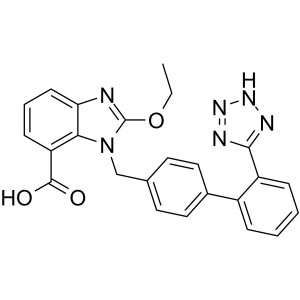
Candesartan CAS 139481-59-7 Purity >99.0% (HPLC...
-

Candesartan Cilexetil CAS 145040-37-5 Assay 99....
-
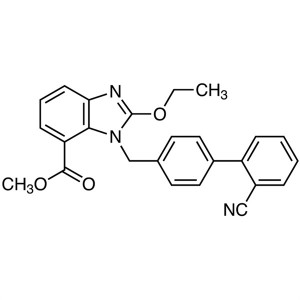
Candesartan Cilexetil Intermediate CAS 139481-4...
-

Candesartan Cilexetil Intermediate Eethyl Ester...
-

Trityl Candesartan Cilexetil CAS 170791-09-0 Pu...
-

4′-Bromomethyl-2-Cyanobiphenyl (Br-OTBN) ...
-

DMDO-Cl CAS 80841-78-7 Purity >96.0% (GC) Olmes...
-
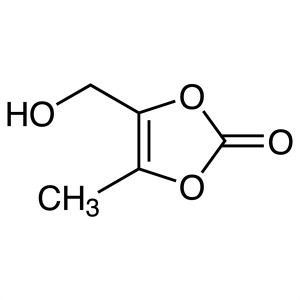
DMDO-OH CAS 91526-18-0 Purity >97.0% (HPLC) Azi...
-

Olmesartan Medoxomil Intermediate CAS 144689-93...
-

Olmesartan Medoxomil CAS 144689-63-4 Purity >99...
-

L-Valine Methyl Ester Hydrochloride (H-Val-OMe·...
-
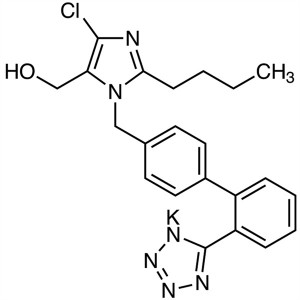
Losartan Potassium CAS 124750-99-8 API Factory ...
-

2-Butyl-4-Chloro-5-Formylimidazole (BCFI) CAS 8...
-
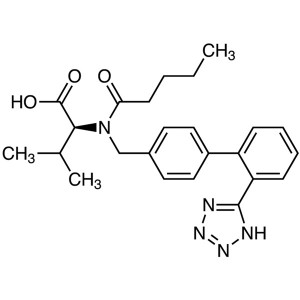
Valsartan CAS 137862-53-4 Assay 98.0~102.0% API...
-

TTBB CAS 124750-51-2 Purity >96.0% (HPLC) Irbes...


